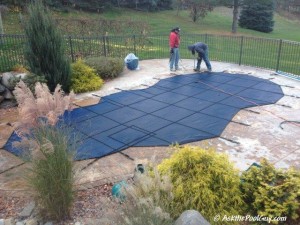For those of us who live in colder climates such as Michigan, closing your pool before the big freeze starts is a must-do. The task can seem daunting. For help, simply follow these tips from Ask the Pool Guy! 


- A week or less before you close your pool, make sure your water is balanced. It needs to be balanced while the pool is in operation and it should also be balanced while it is closed. This will help prevent the growth of bacteria and algae and save you a lot of work when you re-open it. Keep your pH levels between 7.2 and 7.6 ppm, your alkalinity between 80-120 ppm, and calcium hardness levels between 180-220 ppm.
- Shock your pool. After it is completely balanced, use a shock treatment. It can be a chlorine shock treatment or a non-chlorine shock treatment. Following a shock treatment, allow the chlorine level to settle back down before adding an algaecide.
- Remove skimmer baskets and remove all wall fittings, cleaners, or any other equipment you have unnecessarily in your pool.
- Lower you water level (just not if you have a fiberglass pool!) Simply use your filter pump and lover the level about a foot or a foot and a half below the skimmer for mesh covers. If you are using a solid cover, lower it about 3-6 inches. For some pools such as those using Aquador skimmer covers, you will not need to lower the water level.
- Drain all filtering, pumping, and heating equipment. It’s important to do this before water has the ability to freeze and damage equipment. Every pump, filter, heater or chlorinator in your pool has drain plugs to allow water to drain out. If your filter and/or pump are small enough to store indoors, this might be a good option for the winter. If not, try using a shop vac or something similar to blow out any remaining water.
- Apply lubrication to o-rings in your pump.
- Clean your pool thoroughly. Do do this you will most likely need to skim the pool, vacuum the pool, and possibly brush it. The goal is to leave your pool as clean and clear as possible before covering it.
- Winterize the plumbing. This is different than making sure all the water is out of the pump. You want to winterize the plumbing to and from your pool. If you have an in ground pool, the best way to do this is by using a Mighty Vac. You want to blow the air from the skimmer, through equipment, and back to the pool. This will drain the water. If you don’t want to do this, add swimming pool ‘antifreeze’ into the line. Be sure to closely follow the directions on the package. Above ground pools are much simpler to winterize. Simply disconnect the hoses.
- Add algaecide! Do not add the algaecide and the shock at the same time. The chlorine will eat away at the algaecide- leaving it useless.
- Use a pool cover. It’s very important to have a tight-fitting pool cover. Your cover should not have holes or gaps in it. This will leave an open pathway for dirt and debris to enter the water. A mesh safety cover will provide the most protection. Consider a leaf net if you are in a wooded area; they are very useful if you have a lot of trees near your pool.
In areas without cold weather where it rarely reaches below freezing, all these steps are not necessary. Aren’t they lucky! Most people reduce the filtration time per day. Your pool will need fewer chemicals. We recommend you cover your pool if it is not in use because it will reduce the need to clean and shock later on.
If you aren’t up for the task of closing your pool yourself, contact Ask the Pool Guy and a technician will do it for you!
